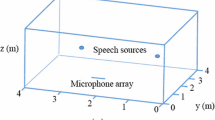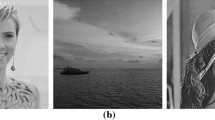Abstract
The traditional natural gradient algorithm works badly when the source signal amplitude changes rapidly or becomes zero at a certain time. In addition, it cannot resolve very well the contradiction between the convergence speed and the error in steady state because the step-size is fixed. In order to solve the above problems, this paper proposes an improved blind source separation algorithm based on non-holonomic natural gradient by choosing an adaptive step-size and a suitable nonlinear activation function. Simulation result demonstrates that the new algorithm performance is superior to the traditional natural gradient algorithm.
Access this chapter
Tax calculation will be finalised at checkout
Purchases are for personal use only
Similar content being viewed by others
References
Hesse CW, James CJ (2006) On semi-blind source separation using spatial constraints with applications in EEG analysis. IEEE Trans Biomed Eng 53(12):2525–2534
Rivet B, Girin L, Jutten C (2007) Mixing audiovisual speech processing and blind source separation for the extraction of speech signals from convolutive mixtures. IEEE Trans Audio Speech Lang Process 15(1):96–108
Abolghasemi V, Ferdowsi S, Sanei S (2012) Blind separation of image sources via adaptive dictionary learning. IEEE Trans Image Process 21(6):2921–2930
Duarte LT, Jutten C, Moussaoui S (2009) A Bayesian nonlinear source separation method for smart ion-selective electrode arrays. IEEE Sens J 9(12):1763–1771
Wei W (2010). Seismic data noise—suppression technique based on blind source separation. Comput Simul 27(11):274–277 (in Chinese)
Duan Z, Ma Y, Peng B et al (2009) Computer simulation analysis of commercial sales based on blind source separation. Comput Simul 26(11):308–311 (in Chinese)
Ji C, Yu P, Yu Y (2010) Blind source separation based on improved natural gradient algorithm. Proc Eighth World Congr Intell Control Autom 31(8):6904–6807 (in Chinese)
Cichocki A, Unbehauen R, Moszczynski R, Rummaert E (1994) A new on-line adaptive learning algorithm for blind separation of source signals. In: Proc. ISANN 94, pp 406–411
Amari S (1998) Natural gradient works efficiently in learning. Neural Comput 10:251–276
Amari S, Cichocki A (1998) Adaptive blind signal processing. Neural network approaches. Proc. IEEE 86:2026–2048
Yang HH, Amari S (1997) Adaptive on-line learning algorithms for blind separation: maximum entropy and minimum mutual information. Neural Comput 7:1457–1482
Amari S, Chen TP, Cichocki A (2000) Non-holonomic constraints in learning algorithms for blind source separation. Neural Comput 12:1463–1484
Jacob B (2000). An introduction to blind source separation of speech signals. Acoustic signal processing for telecommunication. Kluwer Academic, Boston, pp 321–329
Ji C, Tang B, Zhu L (2011) Blind source separation of speech signals based on variable step length natural gradient algorithm. J Central South Univ (Nat Sci) 42(1):661–665 (in Chinese)
Pei X (2007) Blind source separation based on variable step length natural gradient algorithm. Warship Electron Counter 30(4):65–68 (in Chinese)
Yuan L, Wang W, Chambers JA (2005) Variable step-size sign natural gradient algorithm for sequential blind source separation. IEEE Signal Process Lett 12(8):589–592
Acknowledgments
1. National Natural Science Foundation of China (11273001, 61074073, 61273164).
2. New Century Excellent Talents in University (NCET-10-0306), Ministry of Education, China.
Author information
Authors and Affiliations
Corresponding author
Editor information
Editors and Affiliations
Rights and permissions
Copyright information
© 2013 Springer-Verlag Berlin Heidelberg
About this paper
Cite this paper
Ji, C., Tang, B., Yang, K., Sha, M. (2013). Improved Blind Source Separation Based on Non-Holonomic Natural Gradient Algorithm with Variable Step Size. In: Sun, Z., Deng, Z. (eds) Proceedings of 2013 Chinese Intelligent Automation Conference. Lecture Notes in Electrical Engineering, vol 256. Springer, Berlin, Heidelberg. https://doi.org/10.1007/978-3-642-38466-0_84
Download citation
DOI: https://doi.org/10.1007/978-3-642-38466-0_84
Published:
Publisher Name: Springer, Berlin, Heidelberg
Print ISBN: 978-3-642-38465-3
Online ISBN: 978-3-642-38466-0
eBook Packages: EngineeringEngineering (R0)




